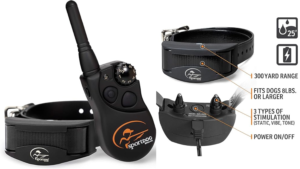Training your dog with an e-collar can be an extremely effective method for reinforcing commands and addressing behavioral issues. However, it’s crucial that e-collar training is approached responsibly and humanely to ensure your dog’s comfort and well-being throughout the process. In this comprehensive guide, we’ll explore everything you need to know about how to train a dog with an e collar. Let’s get started!
What Is an E-Collar and How Does It Work?
An e-collar, also known as a remote training collar or shock collar, is an electronic training device that includes both a handheld remote and a collar receiver worn by your dog. The e-collar allows you to deliver different types of stimulation to your dog from a distance, such as:
- Vibration
- An audible tone
- Static stimulation
By pressing a button on the remote, you can activate the collar to give your dog feedback and reinforce your verbal commands. The stimulation gets your dog’s attention and communicates to stop or change their current behavior. E-collars have multiple adjustable stimulation levels, allowing you to find the perfect setting for your dog based on their temperament and sensitivity. The stimulation should be noticeable to the dog but never painful or frightening.
Knowing When To Use an E-Collar
E-collar training serves two primary purposes:
1. Teaching and Reinforcing Obedience Commands
E-collars are exceptionally helpful for solidifying reliability in basic obedience, such as:
Recall (Coming when called):
One of the most common uses of e-collar training is for improving recall and ensuring your dog listens regardless of distractions. The stimulation acts as an enforcing communication channel when your dog fails to respond to the “come” cue.
Heeling:
Proper leash manners like not pulling and remaining close to your side can also be reinforced with an e-collar at increasing distances.
Sit and Down:
For stationary behaviors like sit and down stays, e-collars provide added reliability even when you move further away from your dog during training sessions.
2. Correcting Unwanted Behaviors
Additionally, e-collars give you a means of effectively stopping undesirable actions your dog engages in, including:
- Excessive Barking: If your dog barks too much, you can use the e-collar to teach them to be quiet on cue.
- Jumping Up: Stop your dog from jumping on guests by stimulating them simultaneously as they start to jump, then rewarding four-on-the-floor behavior.
- Aggression: For dogs who lunge, growl, chase cars or bikes, or have other aggressive tendencies, a remote training collar allows you to safely interrupt and control these behaviors from a distance while keeping tension low through a leash.
Now that you know when e-collars are useful, let’s look at the step-by-step process for introducing your dog to an e-collar and using it for training.
Getting Started: E-Collar Conditioning and Fit
Before ever activating the stimulation, you’ll want to properly introduce your dog to wearing the e-collar comfortably. Getting the right fit and creating a positive association sets the foundation for humane and successful e-collar training.
Choosing the Right E-Collar
To start, you need to select a high-quality e-collar designed for dog training that offers multiple stimulation levels and a reliable, long-range remote. Having various stimulation types like vibration, tone, and static gives you options to find what your dog responds to best. Reputable brands like Dogtra, Garmin, and PetSpy manufacture excellent e-collars suitable for training needs ranging from basic obedience to hunting dogs who need heavy reinforcement. Look for collars with the following features tailored to effective training:
- Adjustable 0-100 or more stimulation levels
- At least 300 yards of range
- Both nick (momentary) and continuous static options
- Multiple collars able to pair with one remote
- Waterproof for versatile training environs
This versatility allows you to reinforce commands in even highly distracting training scenarios.
Fitting the E-Collar Correctly
For consistent performance and your dog’s comfort, properly fitting the collar is imperative. Follow these e-collar fitting guidelines:
- Ensure the collar size appropriately matches your dog’s neck size
- The collar should fit snugly with no excessive tightness or looseness
- The contact points must have full contact with your dog’s skin for conductivity
Having a proper snug e-collar fit ensures consistent stimulation delivery for effective training.
Finding Your Dog’s Working Stimulation Level
Every dog has a unique “working” stimulation level at which they notice the sensation from the e-collar. Through a process called level testing, you will determine your individual dog’s ideal baseline for training. Follow these steps to find your dog’s working level:
- Have your dog next to you in a low-distraction environment with the properly fitted e-collar on.
- Starting at level 1 on the remote, press and hold the stimulation button for 1-2 seconds.
- If your dog shows no reaction, gradually increase the level in increments of 5-10 levels at a time until your dog exhibits a subtle physical response such as:
- Brief head turn
- Ear flick
- Neck twitch
- Your dog’s first mild orienting reaction indicates their baseline working level. This shows they perceive the stimulation while remaining relaxed, focused, and ready to learn.
This entire level testing process should take less than five minutes. You want to keep it low pressure while finding the right sensitivity zone to train ineffectively. Never stimulate your dog at high intensities or do extensive level testing. Only stimulate long enough to determine your dog’s working level threshold, ideally keeping sessions under a minute.
Letting Your Dog Adjust Through Collar Conditioning
After fitting the e-collar and finding your dog’s working level, introduce wearing the inactive collar through a gradual conditioning process that forms a positive association. Follow these conditioning guidelines over 2 weeks:
- Have your dog wear the inert e-collar sporadically throughout the days
- Engage them in fun activities like play, training games, and walks
- Pair high-value treats and praise randomly while they adjust to wearing the collar
- Aim for your dog to relax and ignore the presence of the collar over time
This e-collar desensitization phase gets your dog accustomed, ensuring they don’t correlate the collar itself with receiving stimulation. Proper conditioning and fit set the foundation before incorporating the activated e-collar into training.
Using E-Collar Training Techniques the Right Way
With the prep work in place, you can now leverage e-collars effectively in your training program both for reinforcing obedience and addressing unwanted behaviors.
Proper Timing Makes All the Difference
As with any training, timing is imperative for your dog to properly associate the stimulation with the desired behavior. Follow these timing pointers when using your e-collar:
- Activate the moment your dog disobeys a well-known command
- Cease stimulation instantly when your dog complies or stops the unwanted behavior
- Closely link the stimulation with the exact behavior you want to reinforce or stop
Precise timing ensures your dog relates the stimulation to the behavior and not external factors. Time delays between the behavior and stimulation will confuse your dog.
Combining an E-Collar with Positive Reinforcement
For balanced, ethical training, you’ll want to incorporate e-collar stimulation with positive reinforcement via treats, toys, and praise. This combines clear, enforcing communication from the e-collar with motivation through rewards for good behavior. Using both stimulation and positive reinforcement in harmony gives the clearest guidance to your dog during training.
Introducing the Activated E-Collar
As you introduce the sensation of the activated e-collar to your dog for formal training, follow this progression:
1. Reinforce Known Commands First:
Before correcting behaviors you don’t want, begin using your conditioned working level to solidify command reliability your dog already knows well. This avoids confusion and links stimulation with cementing comprehension of cues like “sit”, “down”, and “stay”.
2. Address Unwanted Behaviors:
Next, turn your focus to applying the e-collar to reduce behaviors you want to minimize or extinguish, like jumping, barking excessively, or pulling on the leash. Timing precision is especially essential in these cases.
3. Distraction Proofing:
Once your dog responds reliably to commands and has reductions in unwanted behaviors from e-collar reinforcement, challenge your training by adding real-world distractions. E-collars prove invaluable for ensuring compliance even when environmental stimuli like other dogs, squirrels, and traffic pull your dog’s focus.
Advancing Your E-Collar Dog Training
As your dog gains competence with e-collar basics, you can level up your training program for advanced off-leash obedience. Here are some tips as you advance your training:
1. Build Distance Slowly
Gradually increase your distance from your dog in each session, ensuring they respond correctly at each incremental step back. Whether you’re proofing a “down-stay” or teaching a recall from play, take progression slowly so your dog truly learns.
2. Use Appropriate Stimulation Levels
Use your remote’s multiple levels wisely by tuning the stimulation intensity to your dog’s drive and the level of distraction. For example, a squirrel 50 yards away commands a higher level to capture your dog’s attention than a nearby leave it cue.
3. Transition to Off-Leash Obedience
Eventually phase out of leash guidance as your dog shows expertise in recall, heel, and other commands influenced by e-collar reinforcement. This allows the freedom of off-leash control even in stimulating environments.
4. Embed Consistency
While advancing your dog’s training, maintain utmost consistency across verbal commands, stimulation type, intensity levels used, and the way you deliver and cease corrections. This consistency cements comprehension. By incorporating these tips for bringing sophistication into your e-collar training regime, your dog will graduate to off-leash reliability and behavioral control rarely attainable solely via positive reinforcement – especially in highly distracting situations.
Conclusion: An E-Collar Can Transform Your Training
Used ethically and correctly, an e-collar delivers immense value as a communication tool between a handler and a dog. E-collar training grants dogs special freedom to explore environments off-leash and participate in activities like hiking simply not possible otherwise without risking safety. However, remember that remote training collars serve only to reinforce commands your dog already knows and act as an enforcing communication channel – never a first-time teaching mechanism. Additionally, they should motivate through stimulus, not punish through pain or intimidation.
FAQs about How To Train A Dog With An E Collar
Is e collar training safe for all dogs?
E collar training can be safe and effective for most dogs when used correctly and under the guidance of a professional trainer. However, it’s essential to consider your dog’s temperament, age, and individual needs before beginning training.
How do I know if I’m using the correct stimulation level?
Start with the lowest stimulation level and gradually increase until you observe a noticeable response from your dog, such as a slight twitch of the ear or a focused attention on you. Avoid using high levels of stimulation, as this can cause stress or discomfort.
Useful Equipment
- Fresh Breathies to finally kiss bad doggie breath goodbye.
- Brush for dog hair.
- Dog Grooming Kit
- Pet Hair Lifter
- The Best High Quality Dog Food
- Pet Merchandise.
Useful Courses
- Brain Training for Dogs – the best & most effective dog training course in the market right now.
So, let us know did you find this article helpful? Are there any other questions you would like us to answer?
Let us know in the comment section down below.
If you are a dog or pet lover in general here are a few more articles you may find interesting:
- HOW TO GET YOUR DOG OR PUPPY TO STOP BARKING
- HOW TO TEACH YOUR DOG TO ROLL OVER
- WHY DO DOGS BREATHE FAST
- HOW TO LEASH TRAIN YOUR DOG
- HOW TO TEACH YOUR DOG TO SHAKE




